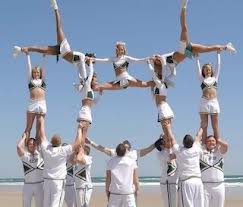Should Cheerleading Become a Real Sport?
Since Johnny Campbell lead the first cheers at a Minnesota University American football game on November 2, 1898, cheerleading has been primarily a support group that leads group cheers on a team at sports events. Cheerleaders may still wear short skirts and wave pom poms when the home team scores a touchdown, but the athletic side of cheerleading has grown complex enough that doctors are calling for it to be considered a sport.
The Athleticism of Cheerleading
Cheerleading has evolved over the past twenty years from being an activity where members were selected based on their popularity to one that now claims some of the more talented athletes at school.
Today, cheerleading involves skills which require the strength of football, the grace of dance, and the agility of gymnastics. Complex maneuvers are performed which challenge the lim its of the body. Safety organizations such as the AACCA were formed to develop safety rules to guide programs in the safe performance of cheerleading gymnastics, which include jumps, partner stunts, pyramids and tumbling.
The athleticism required of modern cheerleading means that institutions must match the development of their cheerleading coaches. In the past, cheerleading teams were able to get along with the support of a faculty "advisor" that did not need to have intricate knowledge of cheerleading skills. Today's cheerleading squad needs a knowledgeable director, more often being called "coach" than "advisor" or "sponsor". These coaches need the training that is given at summer cheerleading training camps and at state and national conventions that provide expert instruction in all areas of cheerleading.
its of the body. Safety organizations such as the AACCA were formed to develop safety rules to guide programs in the safe performance of cheerleading gymnastics, which include jumps, partner stunts, pyramids and tumbling.
The athleticism required of modern cheerleading means that institutions must match the development of their cheerleading coaches. In the past, cheerleading teams were able to get along with the support of a faculty "advisor" that did not need to have intricate knowledge of cheerleading skills. Today's cheerleading squad needs a knowledgeable director, more often being called "coach" than "advisor" or "sponsor". These coaches need the training that is given at summer cheerleading training camps and at state and national conventions that provide expert instruction in all areas of cheerleading.
Why?
Cheerleading isn’t just jumping and waving pompoms — it has become as athletic and potentially as dangerous as a sport and should be designated one to improve safety, the nation’s leading group of pediatricians says. The number of cheerleaders injured each year has climbed dramatically in the last two decades. Common stunts that pose risks include tossing and flipping cheerleaders in the air and creating human pyramids that reach 15 feet high or more.
